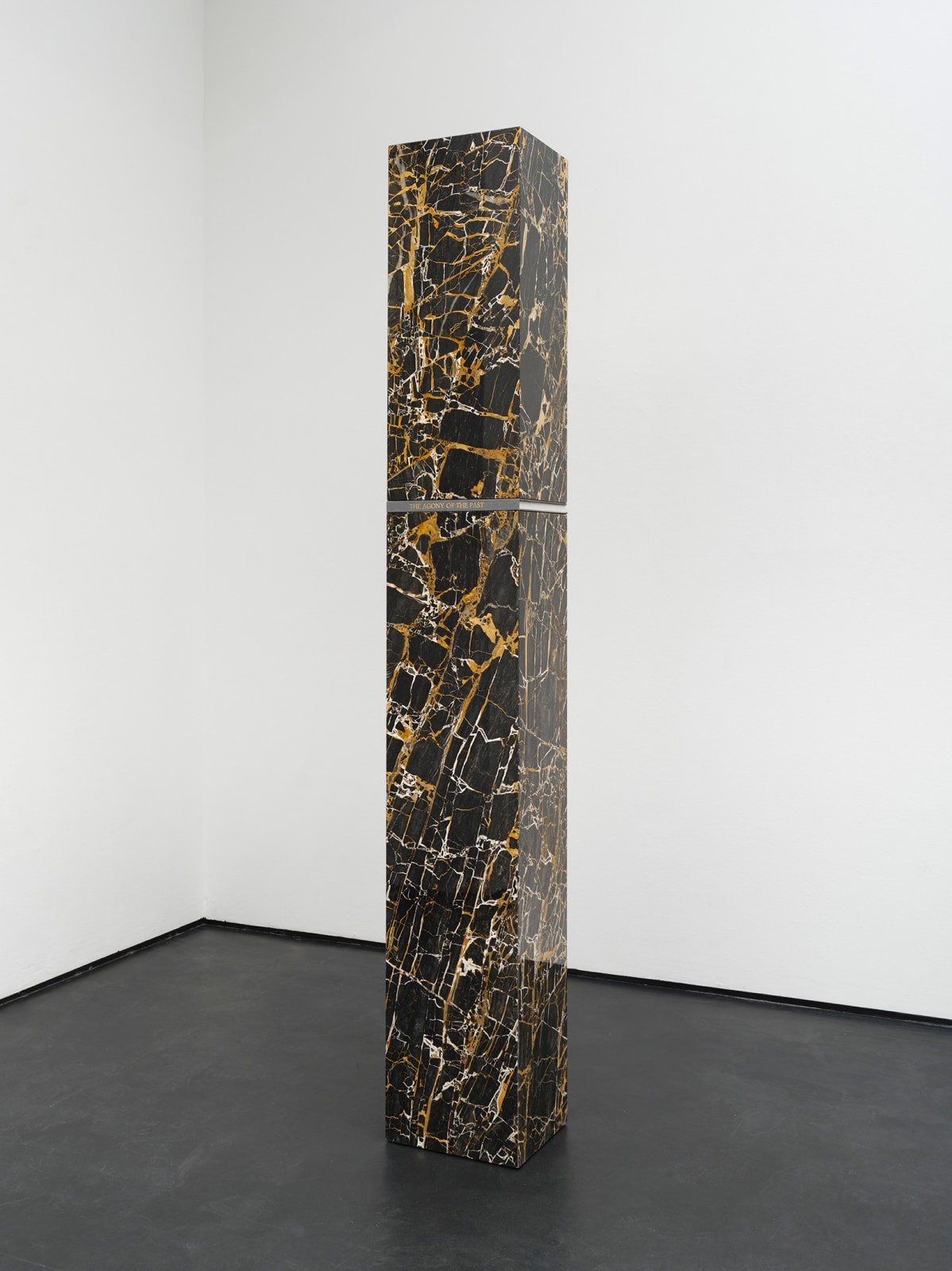Open a larger version of the following image in a popup:
 Photo: Marjorie Brunet Plaza
Photo: Marjorie Brunet Plaza
 Photo: Marjorie Brunet Plaza
Photo: Marjorie Brunet Plaza
Open a larger version of the following image in a popup:
 Photo: Marjorie Brunet Plaza
Photo: Marjorie Brunet Plaza
 Photo: Marjorie Brunet Plaza
Photo: Marjorie Brunet Plaza
Open a larger version of the following image in a popup:
 Photo: Nicolás Lamas
Photo: Nicolás Lamas
 Photo: Nicolás Lamas
Photo: Nicolás Lamas
Open a larger version of the following image in a popup:
 Photo: Marjorie Brunet Plaza
Photo: Marjorie Brunet Plaza
 Photo: Marjorie Brunet Plaza
Photo: Marjorie Brunet Plaza
Nicolás Lamas
The Agony of the Past, 2023
Portoro Leonardo marble and book
222 x 32 x 27 cm
87 3/8 x 12 5/8 x 10 5/8 inches
87 3/8 x 12 5/8 x 10 5/8 inches
Copyright The Artist
Photo: Marjorie Brunet Plaza
Weitere Abbildungen
„The Agony of the Past“ (2023) ist eine Skulptur aus grünem Marmor, die wie ein massiver Pfeiler im Raum steht – ein Monument zwischen geologischer Zeitlichkeit und kultureller Codierung. Zwischen...
„The Agony of the Past“ (2023) ist eine Skulptur aus grünem Marmor, die wie ein massiver Pfeiler im Raum steht – ein Monument zwischen geologischer Zeitlichkeit und kultureller Codierung. Zwischen zwei schweren Marmorschichten eingeklemmt ruht ein Buch mit gleichnamigen Titel. Lamas entzieht dem Buch seine Funktion als Wissensspeicher und macht es zur bloßen Repräsentation von Information – ein Träger menschlicher Erkenntnis in vergänglicher Form, während der Marmor über Jahrtausende hinweg geologische und kulturelle Spuren trägt. Indem das Buch gefangen bleibt, verweist Lamas auf den paradoxen Charakter von Wissen: sichtbar, aber nicht greifbar – zwischen epistemischem Wert und symbolischer Bedeutung. „The Agony of the Past“ entwirft so ein Spannungsfeld zwischen Materialität und Immaterialität, zwischen Autorität und Dekor, Inhalt und Objekt. Lamas dekonstruiert die Mechanismen von Geschichtsschreibung und kultureller Überlieferung, indem er Buch und Stein gleichermaßen als Träger von Erkenntnis und Statussymbol thematisiert. In diesem hybriden Gefüge aus Natur, Wissen und Repräsentation wird Information zur archäologischen Spur, deren Bedeutung sich erst im Kontext erschließt.
“The Agony of the Past” (2023) is a sculpture made of green marble that stands in the room like a massive pillar - a monument between geological temporality and cultural coding. A book with the same title rests wedged between two heavy layers of marble. Lamas strips the book of its function as a repository of knowledge and turns it into a mere representation of information - a carrier of human knowledge in ephemeral form, while the marble bears traces of geology and culture over thousands of years. By keeping the book trapped, Lamas points to the paradoxical character of knowledge: visible but intangible - between epistemic value and symbolic meaning. “The Agony of the Past” thus creates a field of tension between materiality and immateriality, between authority and decoration, content and object. Lamas deconstructs the mechanisms of historiography and cultural tradition by thematizing the book and stone as both carriers of knowledge and status symbols. In this hybrid structure of nature, knowledge and representation, information becomes an archaeological trace whose meaning is only revealed in context.
“The Agony of the Past” (2023) is a sculpture made of green marble that stands in the room like a massive pillar - a monument between geological temporality and cultural coding. A book with the same title rests wedged between two heavy layers of marble. Lamas strips the book of its function as a repository of knowledge and turns it into a mere representation of information - a carrier of human knowledge in ephemeral form, while the marble bears traces of geology and culture over thousands of years. By keeping the book trapped, Lamas points to the paradoxical character of knowledge: visible but intangible - between epistemic value and symbolic meaning. “The Agony of the Past” thus creates a field of tension between materiality and immateriality, between authority and decoration, content and object. Lamas deconstructs the mechanisms of historiography and cultural tradition by thematizing the book and stone as both carriers of knowledge and status symbols. In this hybrid structure of nature, knowledge and representation, information becomes an archaeological trace whose meaning is only revealed in context.



